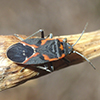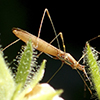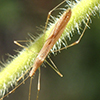Minnesota True Bugs, Hoppers, Aphids,
and Allies
Hemiptera (true bugs) is the order of insects that is characterized by having piercing and sucking proboscis (mouthparts), and wings that are thickened at the base but membraneous (thin, flexible, and often transparent) at the end. The order includes true bugs, whiteflies, aphids, scales, mealybugs, cicadas, leafhoppers, treehoppers, planthoppers, and spittlebugs.
There are about 80,000 named Hemiptera species in 37 families worldwide, 10,200 species in about 1,600 genera in North America north of Mexico.
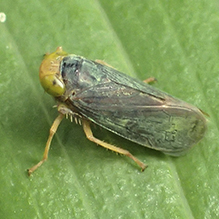
Recent Additions
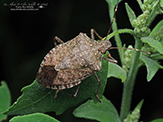
Brown marmorated stink bug (Halyomorpha halys) is an exotic, invasive, true bug. It is native to China, Japan, Korea, and Taiwan. It was accidentally imported into the United States, probably in shipping crates or on machinery. It was first collected in Allentown, Pennsylvania in September 1998, but by then there had already been several sightings. Since its introduction in the U.S., the brown marmorated stink bug has spread rapidly. It now occurs in the east from Maine to Minnesota, south to Florida and eastern Texas, and in the west from northern Washington to southern California. Between these areas there are many scattered sightings and a few expanding populations around the larger metropolitan areas.
Brown marmorated stink bug is a voracious eater. It damages fruits and vegetables, causing pitting or scarring on the outer surfaces. It also damages ornamental crops, causing small, ⅛″ (4 mm) in diameter stippled areas around feeding sites. It is considered an agricultural pest. It feeds on and causes damage to a wide variety of crops, including apples, apricots, Asian pears, cherries, corn (field and sweet), grapes, lima beans, nectarines and peaches, peppers, tomatoes and soybeans. The wounds it creates can be an entryway for diseases to attack the plant.
Brown marmorated stink bug is also a nuisance to humans. In early fall, it begins looking for a place to spend the winter. It frequently finds its way into people’s houses. Often, an individual is found near a window or door, which is its original entry point. Large congregations may be found hiding under furniture like bookcases, beds, or sofas, or under or behind baseboards.
Adults are variable in size, ½″ to ⅝″ (12 to 17 mm) in length. The body appears broad-shouldered and somewhat shield shaped. The color is also variable, usually brownish gray but sometimes brownish yellow, grayish brownish-yellow, orangish brown, or chestnut brown. The entire body is densely covered with tiny dark pits.
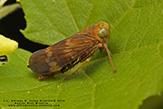
Coppery leafhopper (Jikradia olitoria) is a common, medium-sized, slender leafhopper. It occurs throughout the eastern half of the United States and in adjacent Canadian provinces. In Minnesota it has been recorded only in the southeast quarter of the state.
Coppery leafhopper is said to feed on woody species. In 1975 it was suggested that the subspecies Jikradia olitoria floridana was a vector of strawberry pallidosis. This was later rejected when in 2006 the greenhouse whitefly Trialeurodes vaporariorum was discovered to be the true vector of the disease.
Coppery leafhopper adults are about ¼″ long and variable in color. They are usually light brownish-gray to medium brownish-black, sometimes dark and bluish, sometimes entirely light brownish-yellow. Females always have pale wing bands. Males are always dark brown or rusty brown and have no pale bands.
Little is known of the biology of leafhoppers in the subfamily Coelidiinae.
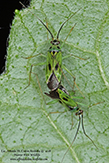
Plant bugs (family Miridae) is the largest family of true bugs (suborder Heteroptera). There are more than 10,000 known species worldwide, several hundred in North America. Green plant bug (Ilnacora malina) is a small, soft-bodied true bug, a medium-sized to large plant bug. It occurs in the United States east of the Great Plains, from Vermont to Minnesota south to Missouri and Virginia, and in adjacent Canadian provinces. Based on the number of reported sightings in North America, it is not very common.
Green plant bug is green with black spots on the forewings and thorax. The forewings have a black membranous section at the tip. The antennae are very long, as long as the forewings. The legs are long, delicate, and green.
Green plant bug is found from mid-June to late July in damp, shady, grassy and weedy areas. It sucks the juices from the leaves and stems of giant ragweed, goldenrod, and possibly other plants.
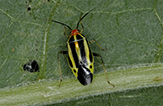
Four-lined plant bug (Poecilocapsus lineatus) is a small, soft-bodied, colorful, true bug. It is common in northeastern and midwestern North America, including Minnesota. It is easily identified by the bright yellow or green body with four black stripes and the orange head. It can be seen from May to July in meadows, gardens, agricultural fields, and around homes.
Four-lined plant bug is considered a pest due to the damage it causes to ornamental plants. Adults and larvae feed on the leaves of herbaceous plants, especially those in the mint and aster families. Leaf damage appears as small, 1 ⁄16″ or less in diameter, light or dark spots on the leaf surface. The color of the spot varies with the species of the host plant. The spots are collapsed leaf tissue which eventually falls out leaving small holes. Larvae cause more leaf damage than adults.
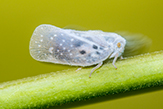
A planthopper is an insect in the superfamily Fulgoroidea that resembles a leaf in its environment. It often hops, like a grasshopper, for transportation, but usually walks slowly to avoid detection. There are more than 12,500 planthopper species worldwide.
Citrus flatid planthopper (Metcalfa pruinosa) is native and very common in eastern North America. It has been introduced into southern Europe and is now an invasive species of concern in orchards and vineyards there. It feeds on a wide variety of woody species including maple, elm, willow, black locust, dogwood, hawthorn, elder, grape, and raspberry.
The body of citrus flatid planthopper is flattened laterally, giving it a wedge-shaped appearance when viewed from above. The wings and body are moderately to densely covered with a mealy, bluish-white, waxy powder. When at rest, the wings are tent-like, almost vertically, over the body. There are two dark spots on the basal half of each forewing.
Other Recent Additions
This list includes only true bugs, hoppers, aphids, and allies that have recorded in Minnesota, but not all of the true bugs, hoppers, aphids, and allies found in Minnesota.
| A | |||||
|---|---|---|---|---|---|
| Profile | Photo | Video | |||
alder lace bug (Corythucha pergandei) |
|||||
alder spittlebug (Clastoptera obtusa) |
|||||
American giant water bug (Lethocerus americanus) |
|||||
aphid (Nearctaphis crataegifoliae) |
|||||
aphid (Uroleucon helianthicola) |
|||||
assassin bugs (Family Reduviidae) |
|||||
aster treehopper (Publilia concava) |
| B | |||||
|---|---|---|---|---|---|
| Profile | Photo | Video | |||
backswimmer (Notonecta borealis) |
|||||
backswimmer (Notonecta irrorata) |
|||||
backswimmer (Notonecta backswimmer) |
|||||
balsam twig aphid (Mindarus abietinus) |
|||||
basswood treehopper (Telamona tiliae) |
|||||
birch lace bug (Corythucha pallipes) |
|||||
black ground bug (Microporus nigrita) |
|||||
black locust treehopper (Vanduzea arquata) |
|||||
black vine weevil (Otiorhynchus sulcatus) |
|||||
brown ambrosia aphid (Uroleucon ambrosiae) |
|||||
brown waterscorpion (Ranatra fusca) |
|||||
buffalo treehoppers and allies (Tribe Ceresini) |
|||||
burrowing bugs (Tribe Geotomini) |
|||||
|
|||||
|
|||||
|
|||||
|
|||||
|
| C | |||||
|---|---|---|---|---|---|
| Profile | Photo | Video | |||
cabbage aphid (Brevicoryne brassicae) |
|||||
camel treehopper (Smilia camelus) |
|||||
Canadian cicada (Okanagana canadensis) |
|||||
caped leafhopper (Macrosteles clavatus) |
|||||
clastopterid spittlebugs (Clastoptera spp.) |
|||||
clover leaf weevil (Brachypera zoilus) |
|||||
clover leafhopper (Ceratagallia sanguinolenta) |
|||||
common damsel bug (Nabis americoferus) |
|||||
common stilt bug (Berytinus minor) |
|||||
|
|
|
|
|
|
|
|
|
|
|
| D | |||||
|---|---|---|---|---|---|
| Profile | Photo | Video | |||
derbid planthopper (Cedusa incisa) |
|||||
derbid planthopper (Cedusa maculata) |
|||||
derbid planthopper (Cedusa vulgaris) |
|||||
dock aphid (Aphis rumicis) |
|||||
dog day cicadas (Neotibicen spp.) |
|||||
|
|||||
|
|||||
|
|||||
|
|||||
|
|||||
|
|||||
|
|||||
|
|||||
|
|||||
|
| F | |||||
|---|---|---|---|---|---|
| Profile | Photo | Video | |||
flat bug (Aradus robustus) |
|||||
four-spotted clover leafhopper (Agallia quadripunctata) |
|||||
|
|||||
|
|||||
|
|||||
|
|||||
|
| G | |||||
|---|---|---|---|---|---|
| Profile | Photo | Video | |||
garden fleahopper (Microtechnites bractatus) |
|||||
giant water bug (Belostoma flumineum) |
|||||
girdled leafhopper (Aphrodes bicinctus) |
|||||
goldenglow aphid (Uroleucon rudbeckiae) |
|||||
goldenrod aphid (Uroleucon solidaginis) |
|||||
grain aphid (Acyrthosiphon dirhodum) |
|||||
green sharpshooter (Draeculacephala antica) |
|||||
|
| H | |||||
|---|---|---|---|---|---|
| Profile | Photo | Video | |||
hackberry lace bug (Corythucha celtidis) |
|||||
hackberry nipplegall maker (Pachypsylla celtidismamma) |
|||||
hawthorn lace bug (Corythucha cydoniae) |
|||||
hemlock woolly adelgid (Adelges tsugae) |
|||||
hill prairie shovelhead leafhopper (Attenuipyga vanduzeei) |
|||||
honeylocust treehopper (Micrutalis calva) |
|||||
|
|||||
|
|||||
|
| I | |||||
|---|---|---|---|---|---|
| Profile | Photo | Video | |||
|
|||||
|
| J | |||||
|---|---|---|---|---|---|
| Profile | Photo | Video | |||
Japanese maple leafhopper (Japananus hyalinus) |
|||||
jewel bug (Homaemus aeneifrons) |
|||||
jewel bug (Homaemus bijugis) |
|||||
|
| K | |||||
|---|---|---|---|---|---|
| Profile | Photo | Video | |||
keeled treehopper (Entylia carinata) |
|||||
|
| L | |||||
|---|---|---|---|---|---|
| Profile | Photo | Video | |||
lace bug (Corythucha mollicula) |
|||||
large daisy aphid (Uroleucon tardae) |
|||||
large fleabane daisy aphid (Uroleucon erigeronense) |
|||||
large thistle aphid (Uroleucon cirsii) |
|||||
leafhopper (Agalliopsis novella) |
|||||
leafhopper (Colladonus montanus) |
|||||
leafhopper (Colladonus waldanus) |
|||||
leafhopper (Doratura stylata) |
|||||
leafhopper (Gyponana gladia) |
|||||
leafhopper (Macropsis basalis) |
|||||
leafhopper (Oncopsis deluda) |
|||||
leafhopper (Oncopsis flavidorsum) |
|||||
leafhopper (Oncopsis minor) |
|||||
leafhopper (Oncopsis variabilis) |
|||||
leafhopper (Scaphytopius angustatus) |
|||||
leafhopper (Scaphytopius cinereus) |
|||||
leafhopper (Scaphytopius cuprescens) |
|||||
leafhopper (Scaphytopius laatus) |
|||||
leafhoppers (Scaphoideus spp.) |
|||||
lettuce root aphid (Pemphigus bursarius) |
|||||
Linne’s cicada (Neotibicen linnei) |
|||||
locust treehopper (Thelia bimaculata) |
|||||
long thin plant bug (Megaloceroea recticornis) |
|||||
lupine bug (Megalotomus quinquespinosus) |
|||||
| M | |||||
|---|---|---|---|---|---|
| Profile | Photo | Video | |||
marbled treehopper (Carynota marmorata) |
|||||
melon aphid (Aphis gossypii) |
|||||
|
|||||
|
|||||
|
|||||
|
|||||
|
| N | |||||
|---|---|---|---|---|---|
| Profile | Photo | Video | |||
narrow stink bug (Mecidea major) |
 |
||||
|
|
| O | |||||
|---|---|---|---|---|---|
| Profile | Photo | Video | |||
oak lace bug (Corythucha arcuata) |
|||||
one-spotted stink bug (Euschistus variolarius) |
|||||
|
| P | |||||
|---|---|---|---|---|---|
| Profile | Photo | Video | |||
pea aphid (Acyrthosiphon pisum) |
|||||
phylloxera gall of hickory (Phylloxera spp.) |
|||||
pine bark adelgid (Pineus strobi) |
|||||
plant bug (Neurocolpus spp.) |
|||||
plant bug (Capsus cinctus) |
|||||
plant bug (Hyaliodes vitripennis) |
|||||
plant bug (Ilnacora stalii) |
|||||
plant bug (Leptopterna ferrugata) |
|||||
plant bug (Neolygus alni) |
|||||
plant bug (Neolygus atritylus) |
|||||
plant bug (Neolygus belfragii) |
|||||
plant bug (Neolygus canadensis) |
|||||
plant bug (Neolygus caryae) |
|||||
plant bug (Neolygus hirticulus) |
|||||
plant bug (Neolygus inconspicuus) |
|||||
plant bug (Neolygus invitus) |
|||||
plant bug (Neolygus omnivagus) |
|||||
plant bug (Neolygus quercalbae) |
|||||
plant bug (Neolygus semivittatus) |
|||||
plant bug (Neolygus tiliae) |
|||||
plant bug (Neolygus viburni) |
|||||
plant bug (Neolygus vitticollis) |
|||||
plant bug (Plagiognathus alboradialis) |
|||||
plant bug (Plagiognathus amorphae) |
|||||
plant bug (Plagiognathus brevirostris) |
|||||
plant bug (Plagiognathus davisi) |
|||||
plant bug (Plagiognathus dispar) |
|||||
plant bug (Plagiognathus flavicornis) |
|||||
plant bug (Plagiognathus fuscosus) |
|||||
plant bug (Sericophanes heidemanni) |
|||||
plant bugs (Phytocoris spp.) |
|||||
plant bugs (Plagiognathus spp.) |
|||||
poplar petiolegall aphid (Pemphigus populitransversus) |
|||||
potato aphid (Macrosiphum euphorbiae) |
|||||
potato mirid (Closterotomus norwegicus) |
|||||
prairie cicada (Okanagana balli) |
|||||
predatory stink bug (Perillus circumcinctus) |
|||||
predatory stink bug (Podisus brevispinus) |
|||||
predatory stink bug (Podisus serieventris) |
|||||
predatory stink bugs (Apoecilus spp.) |
|||||
privet leafhopper (Fieberiella florii) |
|||||
psyllid gall on Juncus (Livia maculipennis) |
|||||
pygmy backswimmer (Neoplea striola) |
| Q | |||||
|---|---|---|---|---|---|
| Profile | Photo | Video | |||
quince treehopper (Glossonotus crataegi) |
|||||
|
| R | |||||
|---|---|---|---|---|---|
| Profile | Photo | Video | |||
red-cross shield bug (Elasmostethus cruciatus) |
|||||
red-tailed leafhopper (Aflexia rubranura) |
|||||
rhododendron leafhopper (Graphocephala fennahi) |
|||||
rice leaf bug (Trigonotylus caelestialium) |
|||||
rough stink bug (Brochymena arborea) |
|||||
|
|||||
|
| S | |||||
|---|---|---|---|---|---|
| Profile | Photo | Video | |||
Say’s Cicada (Okanagana rimosa) |
|||||
scarlet plant bug (Lopidea instabilis) |
|||||
scarlet plant bug (Lopidea media) |
|||||
scarlet plant bugs (Lopidea spp.) |
|||||
sharp-nosed leafhopper (Scaphytopius acutus) |
|||||
sharpshooter (Graphocephala teliformis) |
|||||
shield bug (Elasmostethus atricornis) |
|||||
shield bug (Elasmucha lateralis) |
|||||
shield-backed bug (Eurygaster alternata) |
|||||
shield-backed bug (Phimodera binotata) |
|||||
shield-backed pine seed bug (Tetyra bipunctata) |
|||||
six-spotted leafhopper (Macrosteles fascifrons) |
|||||
spined stilt bug (Jalysus wickhami) |
|||||
squash bug (Anasa tristis) |
|||||
squash vine borer (Melittia cucurbitae) |
|||||
stink bug (Aelia americana) |
|||||
stink bug (Chlorochroa persimilis) |
|||||
stink bug (Coenus delius) |
|||||
stink bug (Dendrocoris humeralis) |
|||||
stink bug (Euschistus ictericus) |
|||||
stink bug (Holcostethus limbolarius) |
|||||
stink bug (Menecles insertus) |
|||||
stink bug (Neottiglossa undata) |
|||||
stink bug (Trichopepla atricornis) |
|||||
sumac gall aphid (Melaphis rhois) |
|||||
|
| T | |||||
|---|---|---|---|---|---|
| Profile | Photo | Video | |||
three-cornered alfalfa hopper (Spissistilus festinus) |
|||||
three-spotted treehopper (Vanduzea triguttata) |
|||||
treehopper (Archasia belfragei) |
|||||
treehopper (Atymna helena) |
|||||
treehopper (Atymna querci) |
|||||
treehopper (Cyrtolobus discoidalis) |
|||||
treehopper (Cyrtolobus fuliginosus) |
|||||
treehopper (Cyrtolobus fuscipennis) |
|||||
treehopper (Cyrtolobus griseus) |
|||||
treehopper (Cyrtolobus maculifrontis) |
|||||
treehopper (Cyrtolobus pallidifrontis) |
|||||
treehopper (Cyrtolobus puritanus) |
|||||
treehopper (Cyrtolobus vau) |
|||||
treehopper (Telamona decorata) |
|||||
turnip aphid (Lipaphis erysimi) |
|||||
turtle bug (Amaurochrous brevitylus) |
|||||
|
|||||
|
|||||
|
|||||
|
|||||
|
|||||
|
|||||
|
|||||
|
|||||
|
|||||
|
|||||
|
|||||
|
|||||
|
|||||
|
|||||
|
|||||
|
|||||
|
| U | |||||
|---|---|---|---|---|---|
| Profile | Photo | Video | |||
 |
|||||
|
|||||
|
|||||
|
|
| V | |||||
|---|---|---|---|---|---|
| Profile | Photo | Video | |||
 |
|||||
Virginia creeper treehopper (Telamona ampelopsidis) |
|||||
|
|||||
|
|
| W | |||||
|---|---|---|---|---|---|
| Profile | Photo | Video | |||
Walker’s cicada (Neotibicen pronotalis) |
|||||
water strider (Family Gerridae) |
|||||
water strider (Limnoporus dissortis) |
|||||
waterscorpion (Nepa apiculata) |
|||||
western damsel bug (Nabis alternatus) |
|||||
western leaf-footed bug (Leptoglossus clypealis) |
|||||
whitecrossed seed bug (Neacoryphus bicrucis) |
|||||
whiteflies (Family Aleyrodidae) |
|||||
widefooted treehopper (Enchenopa latipes) |
|||||
woolly aphids and gall-making aphids (Subfamily Eriosomatinae) |
|||||
woolly apple ahpid (Eriosoma lanigerum) |
| X | |||||
|---|---|---|---|---|---|
| Profile | Photo | Video | |||
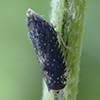 |
|||||
|
|||||
|
|||||
|
| Y | |||||
|---|---|---|---|---|---|
| Profile | Photo | Video | |||
|
|||||
|
| Z | |||||
|---|---|---|---|---|---|
| Profile | Photo | Video | |||
|
|||||
|
Acanalonia bivittata (two-striped planthopper)
Acanalonia conica (green cone-headed planthopper)
Acanalonia spp. (acanaloniid planthoppers)
Acanthocephala terminalis (leaf-footed bug)
Acutalis tartarea (treehopper)
Acyrthosiphon dirhodum (grain aphid)
Acyrthosiphon pisum (pea aphid)
Adelges tsugae (hemlock woolly adelgid)
Adelphocoris lineolatus (alfalfa plant bug)
Aelia americana (stink bug)
Aflexia rubranura (red-tailed leafhopper)
Agallia quadripunctata (four-spotted clover leafhopper)
Agalliopsis ancistra (leafhopper)
Agalliopsis novella (leafhopper)
Agnocoris rubicundus (plant bug)
Aleyrodidae (whiteflies)
Amaurochrous brevitylus (turtle bug)
Anasa armigera (horned squash bug)
Anasa tristis (squash bug)
Aphis fabae (black bean aphid)
Aphis gossypii (melon aphid)
Aphis rumicis (dock aphid)
Aphrodes bicinctus (girdled leafhopper)
Aphrophora alni (European alder spittlebug)
Apoecilus cynicus (brown and orange predatory stink bug)
Apoecilus spp. (predatory stink bugs)
Aradus robustus (flat bug)
Archasia auriculata (eared treehopper)
Archasia belfragei (treehopper)
Arhyssus nigristernum (scentless plant bug)
Atrazonotus umbrosus (umbrose seed bug)
Attenuipyga vanduzeei (hill prairie shovelhead leafhopper)
Atymna helena (treehopper)
Atymna querci (treehopper)
Banasa dimidiata (green burgundy stink bug)
Banasa euchlora (juniper stink bug)
Belostoma flumineum (giant water bug)
Berytinus minor (common stilt bug)
Boisea trivittata (eastern boxelder bug)
Brevicoryne brassicae (cabbage aphid)
Brochymena arborea (rough stink bug)
Capsus cinctus (plant bug)
Carynota marmorata (marbled treehopper)
Cedusa incisa (derbid planthopper)
Cedusa maculata (derbid planthopper)
Cedusa spp. (derbid planthoppers)
Cedusa vulgaris (derbid planthopper)
Ceratagallia sanguinolenta (clover leafhopper)
Ceresini (buffalo treehoppers and allies)
Chaitophorus populicola (poplar leaf aphid)
Chinavia hilaris (green stink bug)
Chlorochroa persimilis (stink bug)
Cicadellidae (typical leafhoppers)
Clastoptera obtusa (alder spittlebug)
Clastoptera proteus (dogwood spittlebug)
Clastoptera spp. (clastopterid spittlebugs)
Closterotomus norwegicus (potato mirid)
Coenus delius (stink bug)
Colladonus clitellarius (saddled leafhopper)
Colladonus montanus (leafhopper)
Colladonus waldanus (leafhopper)
Corythucha arcuata (oak lace bug)
Corythucha celtidis (hackberry lace bug)
Corythucha ciliata (eastern sycamore lace bug)
Corythucha cydoniae (hawthorn lace bug)
Corythucha juglandis (walnut lace bug)
Corythucha marmorata (chrysanthemum lace bug)
Corythucha mollicula (lace bug)
Corythucha pallipes (birch lace bug)
Corythucha pergandei (alder lace bug)
Cosmopepla lintneriana (twice-stabbed stink bug)
Cyrtolobus discoidalis (treehopper)
Cyrtolobus dixianus (treehopper)
Cyrtolobus fuliginosus (treehopper)
Cyrtolobus fuscipennis (treehopper)
Cyrtolobus griseus (treehopper)
Cyrtolobus maculifrontis (treehopper)
Cyrtolobus pallidifrontis (treehopper)
Cyrtolobus puritanus (treehopper)
Cyrtolobus tuberosus (treehopper)
Cyrtolobus vau (treehopper)
Daktulosphaira vitifoliae (grape phylloxera)
Dendrocoris humeralis (stink bug)
Doratura stylata (leafhopper)
Draeculacephala antica (green sharpshooter)
Elasmostethus atricornis (shield bug)
Elasmostethus cruciatus (red-cross shield bug)
Elasmucha lateralis (shield bug)
Enchenopa binotata complex (two-marked treehopper complex)
Enchenopa latipes (widefooted treehopper)
Entylia carinata (keeled treehopper)
Eriosoma lanigerum (woolly apple ahpid)
Eriosomatinae (woolly aphids and gall-making aphids)
Errastunus ocellaris (leafhopper)
Eurygaster alternata (shield-backed bug)
Euschistus ictericus (stink bug)
Euschistus servus (brown stink bug)
Euschistus tristigmus luridus (dusky stink bug)
Euschistus variolarius (one-spotted stink bug)
Fieberiella florii (privet leafhopper)
Geotomini (burrowing bugs)
Gerridae (water striders)
Glossonotus crataegi (quince treehopper)
Graphocephala coccinea (red-banded leafhopper)
Graphocephala fennahi (rhododendron leafhopper)
Graphocephala teliformis (sharpshooter)
Gyponana gladia (leafhopper)
Gyponana octolineata (eight-lined leafhopper)
Halyomorpha halys (brown marmorated stink bug)
Harmostes reflexus (scentless plant bug)
Holcostethus limbolarius (stink bug)
Homaemus aeneifrons (jewel bug)
Homaemus bijugis (jewel bug)
Hoplistoscelis pallescens (damsel bug)
Hyadaphis tataricae (honeysuckle aphid)
Hyaliodes vitripennis (Hart’s hyaline plant bug)
Ilnacora malina (green plant bug)
Ilnacora stalii (plant bug)
Jalysus wickhami (spined stilt bug)
Japananus hyalinus (Japanese maple leafhopper)
Leptoglossus clypealis (western leaf-footed bug)
Leptoglossus occidentalis (western conifer seed bug)
Leptopterna dolabrata (meadow plant bug)
Leptopterna ferrugata (plant bug)
Lethocerus americanus (American giant water bug)
Limnoporus dissortis (water strider)
Lipaphis erysimi (turnip aphid)
Livia maculipennis (psyllid gall on Juncus)
Lopidea instabilis (scarlet plant bug)
Lopidea media (scarlet plant bug)
Lopidea robiniae (black locust bug)
Lopidea spp. (scarlet plant bugs)
Lygaeus kalmii (small milkweed bug)
Lygaeus turcicus (false milkweed bug)
Macropsis basalis (leafhopper)
Macropsis osborni (leafhopper)
Macrosiphum euphorbiae (potato aphid)
Macrosteles clavatus (caped leafhopper)
Macrosteles fascifrons (six-spotted leafhopper)
Mecidea major (narrow stink bug)
Megaloceroea recticornis (long thin plant bug)
Megalotomus quinquespinosus (lupine bug)
Melaphis rhois (sumac gall aphid)
Melittia cucurbitae (squash vine borer)
Membracidae (typical treehoppers)
Menecles insertus (stink bug)
Metcalfa pruinosa (citrus flatid planthopper)
Metriorrhynchomiris dislocatus (plant bug)
Microporus nigrita (black ground bug)
Microtechnites bractatus (garden fleahopper)
Micrutalis calva (honeylocust treehopper)
Mindarus abietinus (balsam twig aphid)
Nabis alternatus (western damsel bug)
Nabis americoferus (common damsel bug)
Nabis americolimbatus (damsel bug)
Nabis roseipennis (damsel bug)
Nabis rufusculus (short-winged nabis)
Nabis subcoleoptratus (black damsel bug)
Neacoryphus bicrucis (whitecrossed seed bug)
Nearctaphis crataegifoliae (aphid)
Neolygus alni (plant bug)
Neolygus atritylus (plant bug)
Neolygus belfragii (plant bug)
Neolygus canadensis (plant bug)
Neolygus caryae (plant bug)
Neolygus communis (pear plant bug)
Neolygus hirticulus (plant bug)
Neolygus inconspicuus (plant bug)
Neolygus invitus (plant bug)
Neolygus omnivagus (plant bug)
Neolygus quercalbae (plant bug)
Neolygus semivittatus (plant bug)
Neolygus tiliae (plant bug)
Neolygus viburni (plant bug)
Neolygus vitticollis (plant bug)
Neoplea striola (pygmy backswimmer)
Neotibicen canicularis (dog day cicada)
Neotibicen linnei (Linne’s cicada)
Neotibicen pronotalis (Walker’s cicada)
Neotibicen spp. (dog day cicadas)
Neottiglossa undata (stink bug)
Nepa apiculata (waterscorpion)
Neurocolpus jessiae (plant bug)
Neurocolpus nubilus (clouded plant bug)
Notonecta borealis (backswimmer)
Notonecta irrorata (backswimmer)
Notonecta lunata (backswimmer)
Okanagana balli (prairie cicada)
Okanagana canadensis (Canadian cicada)
Okanagana rimosa (Say’s Cicada)
Oncopeltus fasciatus (large milkweed bug)
Oncopsis deluda (leafhopper)
Oncopsis flavidorsum (leafhopper)
Oncopsis minor (leafhopper)
Oncopsis variabilis (leafhopper)
Pachypsylla celtidismamma (hackberry nipplegall maker)
Pangaeus bilineatus (peanut burrowing bug)
Paraxenetus guttulatus (plant bug)
Pemphigus bursarius (lettuce root aphid)
Pemphigus populicaulis (poplar leaf-base gall)
Pemphigus populitransversus (poplar petiolegall aphid)
Penthimia americana (leafhopper)
Perillus bioculatus (two-spotted stink bug)
Perillus circumcinctus (predatory stink bug)
Philaenus spumarius (meadow spittlebug)
Phimodera binotata (shield-backed bug)
Phylloxera sp. (phylloxera gall of hickory)
Phymata americana (jagged ambush bug)
Phymata pennsylvanica (Pennsylvania ambush bug)
Phymata spp. (jagged ambush bugs)
Phytocoris eximius (plant bug)
Phytocoris spp. (plant bugs)
Phytocoris tibialis (plant bug)
Pineus strobi (pine bark adelgid)
Plagiognathus alboradialis (plant bug)
Plagiognathus amorphae (plant bug)
Plagiognathus arbustorum (common nettle flower bug)
Plagiognathus blatchleyi (Blatchley’s plant bug)
Plagiognathus brevirostris (plant bug)
Plagiognathus davisi (plant bug)
Plagiognathus dispar (plant bug)
Plagiognathus flavicornis (plant bug)
Plagiognathus fuscosus (plant bug)
Plagiognathus obscurus (obscure plant bug)
Plagiognathus politus (plant bug)
Plagiognathus spp. (plant bugs)
Podisus brevispinus (predatory stink bug)
Podisus maculiventris (spined soldier bug)
Podisus placidus (predatory stink bug)
Podisus serieventris (predatory stink bug)
Poecilocapsus lineatus (four-lined plant bug)
Publilia concava (aster treehopper)
Scaphoideus spp. (leafhoppers)
Scaphytopius angustatus (leafhopper)
Scaphytopius acutus (sharp-nosed leafhopper)
Scaphytopius cinereus (leafhopper)
Scaphytopius cuprescens (leafhopper)
Scaphytopius frontalis (yellow-faced leafhopper)
Scaphytopius laatus (leafhopper)
Scaphytopius magdalensis (blueberry leafhopper)
Scaphytopius spp. (leafhoppers)
Sehirus cinctus (white-margined burrower bug)
Sericophanes heidemanni (plant bug)
Sinea diadema (spined assassin bug)
Sinea spinipes (spiny assassin bug)
Sitobion avenae (English grain aphid)
Smilia camelus (camel treehopper)
Smiliinae (typical treehoppers)
Smiliini (typical treehoppers)
Spissistilus festinus (three-cornered alfalfa hopper)
Stenotus binotatus (two-spotted grass bug)
Stictocephala diceros (two-horned treehopper)
Taedia scrupea (variable eastern taedia mirid)
Telamona ampelopsidis (Virginia creeper treehopper)
Telamona decorata (treehopper)
Telamona monticola (treehopper)
Telamona tiliae (basswood treehopper)
Tetyra bipunctata (shield-backed pine seed bug)
Thelia bimaculata (locust treehopper)
Thyanta custator (red-shouldered stink bug)
Trichopepla atricornis (stink bug)
Trigonotylus caelestialium (rice leaf bug)
Uroleucon ambrosiae (brown ambrosia aphid)
Uroleucon cirsii (large thistle aphid)
Uroleucon erigeronense (large fleabane daisy aphid)
Uroleucon helianthicola (aphid)
Uroleucon nigrotuberculatum (red goldenrod aphid)
Uroleucon obscuricaudatum (dusky-tailed sunflower aphid)
Uroleucon rudbeckiae (goldenglow aphid)
Uroleucon solidaginis (goldenrod aphid)
Uroleucon spp. (large daisy aphids)
Uroleucon tardae (large daisy aphid)
Vanduzea triguttata (three-spotted treehopper)
Vanduzea triguttata (three-spotted treehopper)
No Species Page Yet?
If you do not see a linked page for a species in the list at left you can still upload a photo or video or report a sighting for that species. Click on one of the buttons below and type in the common name and/or scientific name of the species in your photo, video, or sighting. A new page will be created for that species featuring your contribution.
These buttons not working for you?
Simply email us at info@MinnesotaSeasons.com.
Capitalization (or not) of Common Names
Insect scientific names are governed by the International Commission on Zoological Nomenclature (ICZN). Vernacular (common) names are not. In an attempt to “assure the uniformity of (common) names of common insects” the Entomological Society of America (ESA) published Common Names of Insects and Related Organisms. ESA has no rule or guideline that addresses capitalization of common names. However, the database of common names published by ESA does not capitalize common names. Most other sources, including ITIS, BAMONA, Odonata Central, and the Peterson Field Guides, capitalize common insect names. MinnesotaSeasons.com will adhere to the convention followed by ESA.

















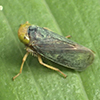




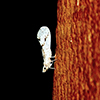




























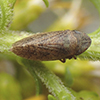


_02t.jpg)
































